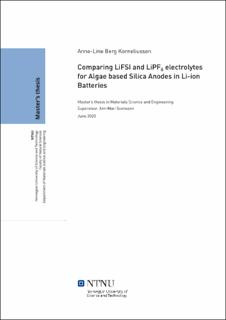| dc.contributor.advisor | Svensson, Ann Mari | |
| dc.contributor.advisor | Blanco, Maria Valeria | |
| dc.contributor.advisor | Renman, John Viktor Emanuel | |
| dc.contributor.author | Korneliussen, Anne-Line Berg | |
| dc.date.accessioned | 2021-09-28T18:02:37Z | |
| dc.date.available | 2021-09-28T18:02:37Z | |
| dc.date.issued | 2020 | |
| dc.identifier | no.ntnu:inspera:59547306:14960742 | |
| dc.identifier.uri | https://hdl.handle.net/11250/2785260 | |
| dc.description.abstract | Energiteknologi har en stor innvirkning på samfunnet vårt, alt fra miljøutfordringer og økonomisk utvikling til forbruker elektronikk og transportsektoren påvirkes av energiteknologi. I fremtiden vil energiteknologier, slik som batterier, fortsette å vokse. Derfor har det i nyere år blitt forsket alternative materialer til å erstatte grafittanodene i kommersielle Li-ion batterier. Silisiumoksid utvinnet fra kiselalger er et av materialene som har blitt undersøkt, da det er rimelig, miljøvennlig og har en høy teoretisk kapasitet.
I dette arbeidet er effekten av litiumsalt studert ved å analysere de elektrokjemiske dataene fra celler med forskjellig aktivt materiale og forskjellige elektrolytter, dvs. elektrolytter med forskjellige litiumsalt. Silisiumoksidet som ble brukt er utvunnet fra kiselalger og malt opp for å redusere partikkelstørrelsen. Elektroder av «rent» silisiumoksid og karbonbelagt silisiumoksid ble laget med 15 vekt% vannløselig Na-alginat og 10 vekt% karbon (carbon black). Battericeller ble laget med de to forskjellige elektrolyttene, som inneholdt henholdsvis litium-bis(fluorosulfonyl)imid (LiFSI) salt og litiumheksafluorfosfat (LiPF6) salt. Cellene ble syklet galvanostatisk med samme syklingsprogram. Etter endt sykling ble postmortem karakterisering med røntgenfotoelektron-spektroskopi utført, i tillegg til ytterligere karakterisering med focused ion beam (FIB) og skanning elektronmikroskop (SEM) på utvalgte elektroder.
Kapasiteten til de karbonbelagte silisiumoksidanodene var som forventet høyere enn kapasiteten til «rene» silisiumoksidanoder. For karbonbelagt silisium oppnådde celler med LiPF6 en gjennomsnittlig kapasitet på 669 mAh/g, mens celler med LiFSI oppnådde en kapasitet på 598 mAh/g, dvs. at celler med LiPF6 oppnådde en høyere kapasitet enn celler med LiFSI. For "ren" silisium oppnådde celler med LiFSI imidlertid høyere kapasitet enn celler med LiPF6, da gjennomsnittlig kapasitet var henholdsvis 554 mAh/g og 516 mAh/g for LiFSI of LiPF6. Denne forskjellen i ytelse mellom LiFSI og LiPF6 er knyttet til SEI (solid electrolyte interface)-formasjonen og egenskapene til SEIen. For de karbonbelagte silisiumoksid cellene med LiFSI ble det observert en synkende trend i kapasitet under sykling, noe som indikerte nedbryting av cellen. De andre cellene viste derimot god sykkelstabilitet. Analyse av den coulombiske-effektiviteten avslørte at "rene" silisiumoksid anoder oppnådde en høyere coulombisk-effektivitet enn karbonbelagte silisiumoksid anoder, uavhengig av type elektrolytt.
Videre studier av SEI med XPS indikerte at SEI-formasjonen skjer på et høyere potensial for LiFSI enn LiPF6. I tillegg ble det observert en forskjellige i hvor de ulike organiske og uorganiske komponentene kan lokaliseres i SEI, hvilke indikerte at SEI dannet med LiFSI er mer fleksibel, men også mer ledende enn SEI dannet med LiPF6. | |
| dc.description.abstract | Energy technology has a vast impact on our society, ranging from environmental challenges and economic development to consumers' electronics and transportation. Looking forward, energy technologies, such as batteries, are predicted to keep growing. In recent years, silica extracted from diatom frustules has been explored as a replacement for graphite anodes in commercial Li-ion batteries, as it has low cost, environmentally friendly and yields a high theoretical capacity.
In this work, the effect of the lithium salt was studied by analysis of the electrochemical data of silica cells with different electrolytes, i.e. electrolytes containing different lithium salts. The silica was extracted from diatom frustules and milled to reduce the particle size. Electrodes with "pure” silica or carbon-coated silica were prepared with 15 wt% water soluble Na-alginate and 10 wt% carbon black. Two different electrolytes, with lithium bis(fluorosulfonyl)imide (LiFSI) and lithium hexafluorophosphate (LiPF6) salt respectively, were used when assembling the coin cells. The cells were cycled galvanostatically with the same cycling programs. After cycling, postmortem characterization was performed by X-ray photoelectron spectroscopy, and also focused ion beam and scanning electron microscopy characterization for selected electrodes.
The capacity of the carbon-coated silica anodes was, as expected, higher than the capacity of silica anodes. For the carbon-coated silica, cells with LiPF6 obtained an average capacity of 669 mAh/g whereas cells with LiFSI obtained a capacity of 598 mAh/g , i.e cells with LiPF6 obtained a higher capacity than cells with LiFSI. However, for "pure" silica, cells with LiFSI obtained higher capacity than cells with LiPF6, 554 mAh/g and 516 mAh/g respectively. The latter is most likely attributed to the SEI formation and the SEI properties. For the carbon-coated silica cells with LiFSI, a small cell degradation was observed, as opposed to the other cells which exhibited good cycling stability. Analysis of the coulombic efficiency revealed that "pure" silica anodes obtained a higher coulombic efficiency than carbon-coated silica cells, regardless of the electrolyte.
Further study of the SEI with XPS indicated that the SEI formation happens at a higher potential for LiFSI than LiPF6. In addition, a difference in where the inorganic and organic components are located in the SEI was observed, indicating that the SEI formed with LiFSI is both more flexible but also more conductive than the SEI formed with LiPF6. | |
| dc.language | | |
| dc.publisher | NTNU | |
| dc.title | Comparing LiFSI and LiPF6 electrolytes for Algae based Silica Anodes in Li-ion Batteries | |
| dc.type | Master thesis | |
